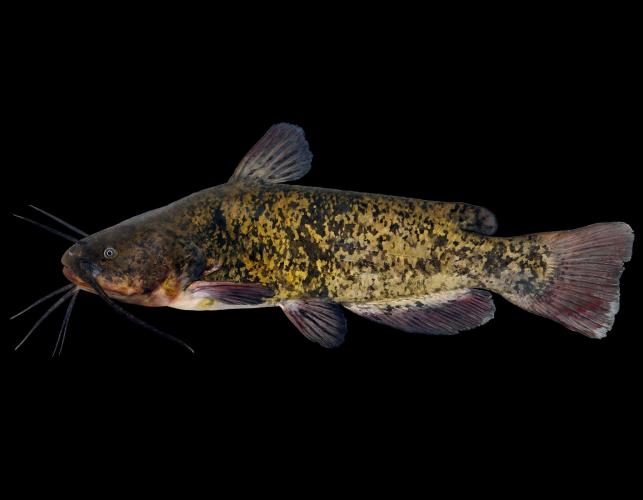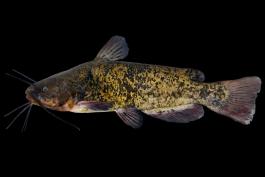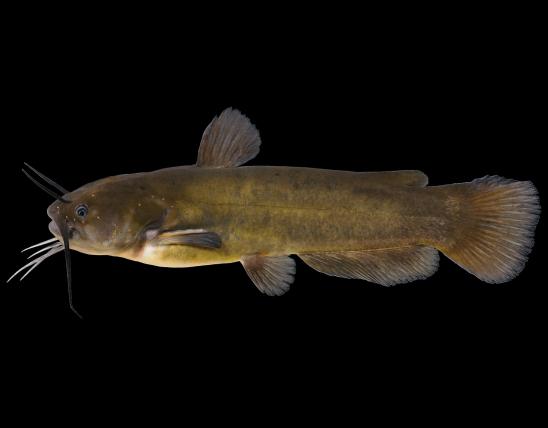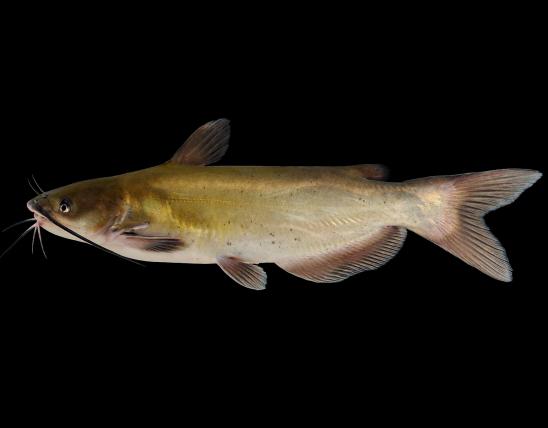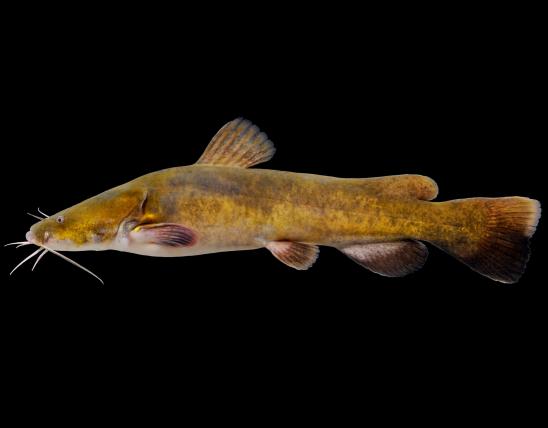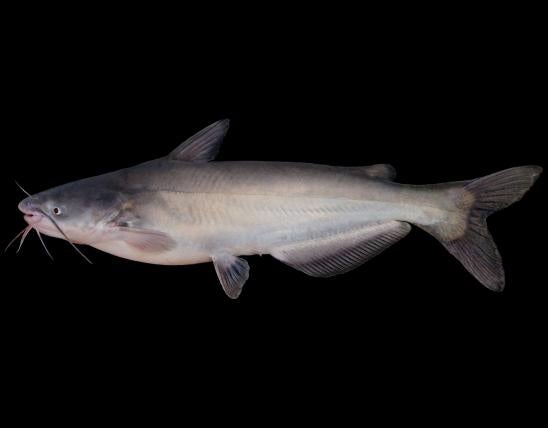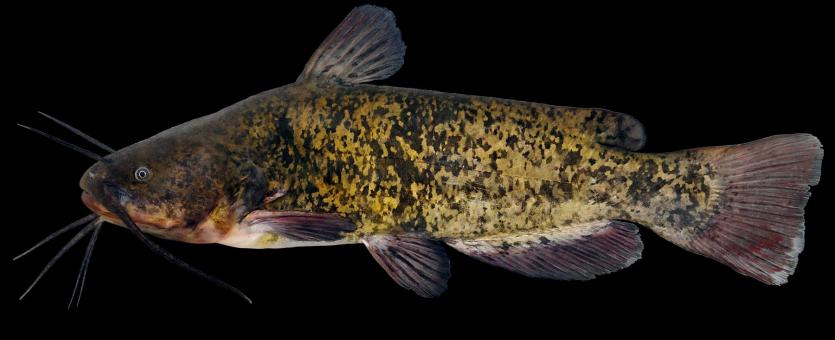
In Missouri, the brown bullhead occurs in quiet, clear waters in wildlife refuges in Bollinger, Stoddard, and Wayne counties. Elsewhere in the state, it is stocked and possibly escapes. It has mottled sides and has an elongated barbel at the corner of the mouth.
Bullhead catfishes, as a group, are chubby catfish that rarely exceed 16 inches in length. The upper jaw projects beyond the lower jaw. The tail is not noticeably forked. The adipose fin (on the back, between the dorsal fin and tail) is a free lobe, widely separate from the tail fin.
The brown bullhead can be distinguished from Missouri’s three other bullheads by the following: The back and sides are usually strongly mottled rather than uniformly colored, and the barbel at the corner of the mouth is longer, reaching well behind the base of the pectoral fin in adults. Sawlike teeth are well developed on the rear margin of the pectoral spine (teeth can be detected by grasping the spine between the thumb and forefinger and pulling outward). The anal fin rays usually number 22 or 23. The chin barbels are dusky or black (never uniformly white). The length of the anal fin base is less than the length of the head (measured from tip of snout to outer edge of the gill cover). The rear margin of the tail fin is slightly notched, as in the black bullhead.
The back and sides are dark yellowish brown, usually strongly mottled with darker brown or black. The belly is yellowish or white. The fins are dusky or black, with the membranes often darker than the rays.
Similar species:
- The black bullhead (A. melas) is more common and has a wide range in Missouri, especially in north and west portions of the state. Its back and sides are uniformly colored (not strongly mottled with a darker color); it lacks sawlike teeth on the rear margin of the pectoral spine; its anal fin rays usually number 17–21; and its chin barbels are dusky or black. The barbel at the corner of the mouth is shorter, not reaching behind the base of the pectoral fin.
- The yellow bullhead (A. natalis) is more common and has a wide range in Missouri, especially in the Ozarks and Bootheel lowlands. Its back and sides are usually uniformly yellowish brown (often faintly mottled with darker brown in adults from clear, weedy water); its chin barbels are uniformly whitish (may be slightly dusky in large Ozarks specimens but not grayish or blackish); its anal fin rays usually number 24–27; the rear edge of the tail fin is nearly straight (not slightly notched); and the barbel at the corner of the mouth is shorter, not reaching behind the base of the pectoral fin.
- The white catfish (A. catus, sometimes Ictalurus catus), another bullhead, shares the relatively short anal fin and blunt (not wedge-shaped) head of our other bullheads, but it has a moderately (though not deeply) forked tail fin. It commonly reaches 10–18 inches long; maximum about 24 inches. It’s not native to Missouri but is commonly stocked in fee-fishing lakes and other private waters. Where it has been occasionally collected from natural waters in Missouri, those individuals probably represent escapees. It has been collected in the Missouri and Mississippi rivers and the Big Creek arm of Truman Reservoir. It probably does not breed here, except perhaps in artificial ponds.
Adult length: commonly 7–15 inches, with a maximum of about 18 inches; weight: commonly 0.3–2.2 pounds, with a maximum of about 3.7 pounds.
In Missouri, the only confirmed self-sustaining natural population of brown bullheads occurs at Duck Creek Conservation Area and nearby Mingo National Wildlife Refuge, in Stoddard, Bollinger, and Wayne counties of southeastern Missouri. It has also been collected in a 12-acre lake owned by the city of Arnold on the floodplain of the Meramec river in Jefferson County; in Truman Reservoir when it first filled; and possibly elsewhere.
Habitat and Conservation
The brown bullhead seems to prefer quiet, clear waters with moderate or large amounts of submerged aquatic vegetation. Its habitat requirements are much like those of the yellow bullhead, but it is found less frequently in flowing waters.
Food
The brown bullhead, like other catfishes, relies on an acute sense of smell to find its food. Like the black bullhead, the brown bullhead feeds primarily from the bottom on a variety of plant and animal material. Early in life, the diet is mostly small crustaceans, while adults feed primarily on immature aquatic insects. Most feeding occurs at night, as with most catfish.
Status
A Species of Conservation Concern in Missouri, the brown bullhead is ranked as possibly vulnerable to extirpation from our state. It probably used to occur more widely in our Bootheel counties, before most of the presettlement swamp habitat in that region was drained and converted to agriculture. Today’s populations undoubtedly represent a great reduction of historic numbers due to the much-reduced percentage of its former Missouri range.
The brown bullhead’s greater North American range is to the north (extending into Canada), east, and southeast of Missouri. Missouri’s Bootheel appears to be the only part of its Missouri that is contiguous with its overall range.
Life Cycle
The brown bullhead’s life history is similar to that of the black bullhead. Spawning in Missouri probably occurs in May or June. The female excavates a saucer-shaped nest, often beneath logs, rocks, or other large, elevated objects. One of the parents remains continuously over the eggs, warding off predators and aerating the eggs by fanning water over them with the fins. The parents typically stay with the young until about 5 days after hatching. In the wild, the lifespan is typically 6–8 years.
Human Connections
In the origin stories of the Ojibwe people, the brown bullhead (Wawaazisii) was one of six beings who emerged from the sea to become founders of the six original clans of Ojibwe. Traditionally, members of the bullhead clan and its offshoot fish clans were characterized as being teachers, scholars, nurturers, and mediators. Given their admirable degree of parental care, bullheads would be a good example of “nurturing” in the animal world.
The brown bullhead has been stocked in various places throughout the United States for food or for sport fishing.
Ecosystem Connections
Once they attain a fairly large size, brown bullheads have fewer predators, but bullhead eggs and fry are easy pickings for a wide variety of aquatic predators, including sunfish and even minnows, which hover about the nest, waiting for them to be unguarded for a moment. This explains the parent bullheads’ diligent nest-guarding behavior.
In general, predators of bullheads include any fish large enough to consume them, plus watersnakes, snapping turtles, herons, and raccoons.
As a defense against predation, bullheads (like many other catfish), when attacked, typically stretch out and lock their dorsal and pectoral spines, which makes them much harder to swallow.
